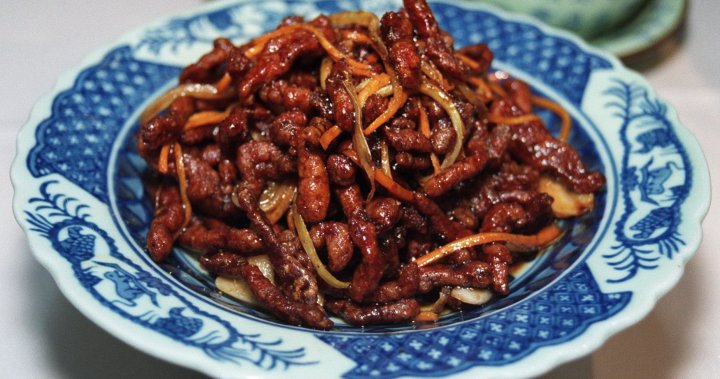An Ode to Ginger Beef: The Hidden History of Chinese-Canadian Cooking
For many Calgarians, ginger beef is a signature dish of their beloved city. In fact, he is adored all over Alberta.
The dish is a plate of battered and fried strips of beef often sautéed with ginger, peppers and onions. It is then finished with a sticky, spicy sauce and served over a bed of plain or fried rice.
A plate of ginger beef.
Jonathan Wong/South China Morning Post via Getty Images
It has become a staple in Chinese restaurants and food courts across Canada. Look at any Chinese food stall in a Canadian mall and you’ll likely see ginger beef on a serving tray.
Read more:
‘One of many wrongs to be righted’: Calgary closes in on James Short Park name change
Read more
-
![]()
‘One of many wrongs to be righted’: Calgary closes in on James Short Park name change
But the humble dish also represents a collective struggle to survive on foreign soil.
Silver Inn Restaurant, a family-run Chinese restaurant in Calgary, is said to have invented ginger beef as a way to introduce new Chinese dishes to Western palates.
Silver Inn restaurant owner Kwong Cheung stands outside on Tuesday, October 11, 2022.
World News
It was first opened in 1975 by two sisters from Hong Kong, Louise Tang and Lily Wong, who remodeled an old cafe just outside Calgary’s Chinatown.
According to its website, Silver Inn’s original menu featured Western-style and Beijing-style Chinese dishes to cater to primarily non-Chinese diners who were unaccustomed to authentic fare.
After 47 years in the business, the restaurant finally closed its doors on Sunday. The business was so iconic that it had its sign stolen the next day (it has since been returned to the owner).
“Like any dish, it was made by mistake,” owner Kwong Cheung said.
“My older brother was a chef by training, and when we decided to open the restaurant, he noticed that Canadians liked to eat fries. Of course, being Alberta, people liked to eat beef.
“We were trying to find a way to mix the two together… We figured out that we could get the beef and make it as crispy as a fry and then pair it with a sweet and sour sauce a bit like ketchup.
“We wanted to adapt to the local palate.

Cheung said his family never noticed how popular ginger beef had become until years later as they struggled to make the business successful.
“When we opened the restaurant in 1975, we were the first to serve (Beijing-style) food. We were thinking about how to survive the first six months. We never thought about leaving a legacy or anything like that,” the restaurant owner said.
“At the time it all took off, we were so busy that we never thought of anything but satisfying the customers… We should have – we could have retired even sooner!”
Read more:
The rise and fall of Chinatown: the hidden story of displacement you’ve never been told
Ginger beef is one of many dishes created as a result of Chinese-Canadian immigration. Chop suey and pork mu shu are two examples of dishes created by Chinese immigrants.
But these dishes often have a painful history. In the 1850s, many Chinese workers faced language barriers upon arriving in Canada, forcing them either to work on the Canadian Pacific Railway for starvation wages or to open businesses.
These Chinese restaurateurs often had to modify dishes or entire menus to suit the predominantly Western palate and create a successful business.
“In the 1800s, they were often the only Chinese in these towns. Their customers are usually of European descent and have eaten at these restaurants because they came to Canada without family,” said Josephine Smart, a retired professor of anthropology at the University of Calgary.
“If you look up old menus, you’ll notice that Chinese-run cafes sometimes didn’t include a single Chinese item, and if they did, it would be a very limited selection.”
Read more:
Calgary’s Chinatown reports up to 80% drop in business over COVID-19 fears
These restaurants also served as community hubs for Chinese immigrants who often came to North America without their families due to the racist immigration policies of the time.
“They would also serve as catering for Chinese immigrants who work in the same place, but they would order from very different menus. Sometimes it’s just an oral menu: what the owner has available today,” Smart said.
Smart said traditional restaurants like Silver Inn and Golden Inn are embedded in Canadian culture because they’ve been around for so long.
Golden Inn was a restaurant known for its salt and pepper calamari, located in Calgary’s Chinatown. The restaurant closed in August after 45 years in business.
“You have Chinese who grew up in Canada and non-Chinese Canadians who eat these types of foods and are exposed to Chinese-Canadian culture. It is part of the Canadian cultural fabric.
“Overall, when you look at the history of Canada, Chinese immigrants play an important role. They are best known for working on the Canadian Pacific Railway and being servants for wealthy farmers and ranchers… The Chinese have contributed economically and historically in innovative ways.

The Evolution of Modern Chinese-Canadian Cuisine
Smart disagreed that the closure of old Chinese restaurants meant the downfall of Chinatown. Rather, it is an opportunity to introduce new Chinese cultural elements to cities like Calgary and Vancouver.
“A lot of these restaurateurs don’t want their children working in very demanding industries. They worked very hard to get the income and upward mobility that others couldn’t. Children often have Canadian educations and higher credentials than their parents,” Smart said.
“Cultural heritage cannot be locked away. You can’t freeze it because it’s a living thing. You cannot save a preconceived idea of cultures frozen in time.
“Market demands are also changing… Their demise should not be viewed as a tragedy, but as part of the natural business cycle of the service industry.”
Read more:
Calgary and Edmonton among 6 Canadian Chinatowns to ask for post-pandemic supports
Chinese-Canadian cuisine is also changing. Many chefs are pushing the boundaries of traditional dishes, paving the way for “neo-Asian” cuisine and restaurants. New Asian cuisine is an umbrella term for dishes that incorporate traditional flavors with modern cooking and plating techniques.
Nick Liu, executive chef and owner of Dai Lo in Toronto, believes new Asian cuisine is creating more opportunities for Asian chefs to express their heritage and creativity. Dai Lo, which means big brother in Cantonese, is a Chinese restaurant that follows French cooking techniques.
Nick Liu is the executive chef and owner of Dai Lo, a Chinese restaurant in Toronto.
Contributed by Nick Liu
Liu was inspired by his Hakka Chinese heritage and wanted to find a way to combine his French training with the food he ate growing up.
Although he acknowledges that Cantonese-style dishes like ginger beef are influential in Chinese-Canadian cuisine, Liu said he was never comfortable cooking these dishes.
“The inspiration has always been to put my family and my culture first. I was trained in French and wanted to try to find a way to take the food I was raised with and find a symbiotic relationship with the places where I worked,” Liu told 770 CHQR.
“I wanted to incorporate them into a style of cooking and a style of restaurant that I would be proud of…I’ve been cooking for a long time now, and if I feel something about this food, subconsciously diners are going to feel something about it too.
Read more:
Major Calgary Chinatown development project gets green light from city
Liu also said that new Asian cuisine allowed him to learn more about his culture and heritage. Like many first-generation Asian immigrants, her ethnicity was often an internal and societal struggle.
“There were times when I hated being Chinese. In fact, I avoided being Chinese. It’s the racism of my own people, but also the experience when you try to fit in with white and Canadian kids… You become a product of your environment,” the executive chef said.
“It took me a very long time to become Asian again. I really have to thank the food (of my culture) and (being able to) learn to cook Asian dishes. This is how I re-learned my culture and became proud to be Asian.
“It’s amazing how (new Asian cuisine) is changing people’s perception of Chinese culture. That’s what did this to me. The more I learned about my food and my family history, the more I learned about the roots of the dishes I riff on.





Comments are closed.